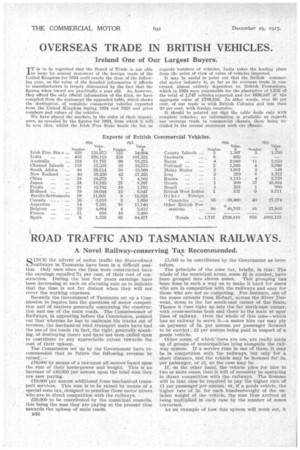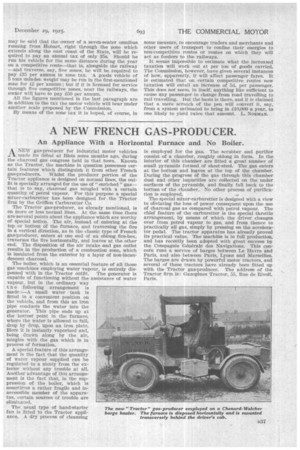iR OAD TRAFFIC AND TASMANIAN RAILWAYS.
Page 20

Page 21

If you've noticed an error in this article please click here to report it so we can fix it.
A Novel Railway-conserving Ta..1 Recommended.
SINCE the advent of motor, traffic the State-owned railways in Tasmania have been in a difficult position. Only once since the lines were constructed have the earnings equalled '21 per cent. of their cost of construction. During the last few years earnings have been decreasing at such an alarming rate as to indicate that the time is not far distant when they will not cover the working expenses.
Recently the Government of Tasmania set up a Commission to inquire into the questions of motor competition and of matters generally concerning the construction and use of the main roads. The Commissioner of Railways, in appearing before the Commission, pointed Out that whereas he has to maintain his tracks out of revenue, the mechanical road transport users have had the use of the roads (in fact, the right, generally speaking, of destroying them) and have not been called upon to contribute to any appreciable extent towards the cost of their upkeep. .
The Commission set up by the Government have recommended that in future the following revenue be raised : £70,000 by means of a tax upon all motors based upon the sum of their horse-power and Weight. This is an increase of 140,000 per annum upon the total sum they are now paying.
£10,000 per annum additional from mechanical transport services. This sum is to be raised by means Of a special zone tax,, designed te penalize those motor hirers. who are in direct competition with the railways.
£20,000 to be contributed by the municipal councils, this being the sum they are paying at the present time towards the upkeep of main roads.
B36 £5,000 to be contributed by the Government as heretofore.
The principle of the zone tax, briefly, is this: The whole of the municipal areas, some 42 in number, have been grouped into eleven zones. This grouping has been done in such a way as to make it hard for users who are in competition with the railways and easy for those who are not so competing. For instance, one of the zones extends from Hobart, across the River Derwent, down to the far south-east corner of the State. Thence it runs right up into the far north-east corner, with cross-sections here and-there to the Main or spur . lines of railway. Over the whole of this zone-which has no railway to serve It-a motor hire ear may ply on payment of Ss. per annum per passenger licensed to be carried; 12 per annum being paid iu respect of a goods vehicle.
Other zones, of which'there are ten,--are really made up of groups of municipalities lying alongside the railway system. If a service runs in one of these, it may be in competition with the railways, hut only for a short distance, and the vehicle may be licensed for 5s, per passenger, or 12, as the case may be.
If, on the other hand, the vehicle plies for hire in two or more zones, then it will of necessity be operating in direct 'competition with the rallivays. The licensee will in that case be required to pay the higher rate of per passenger per annum; or, if a goods vehicle, the higher rate of 2s. for each hundredweight of the unladen Weight of the vehicle, the sum thus arrived at being multiplied in each case by the number of zones traversed.
As an example of how this system will work out, it may be said that the owner of a seven-seater omnibus running from Hobart, right through the zone which extends along the east coast of the State, will be required to pay an annual tax of only 35s. Should he run his vehicle for the same distance during the year on a competitive route—that is, alongside the railway —and traverse, say, five zones, he will be required to pay £35 per annum in zone tax. A goods vehicle of 5 tons unladen weight may be run in the first-mentioned zone for £2 per annum; but if it is licensed for service through five competitive zones, near the railways, the owner will have to pay £50 per annum. All the figures mentioned in the last paragraph are in addition to the tax the motor vehicle will bear under another scale proposed by the Commission.
By means of the zone tax it is hoped, of course, in some measure, to encourage traders and merchants and other users of transport to confine their energies to non-competitive routes or routes on which they will act as feeders to the railways.
It seems impossible to estimate what the increased taxation will work out at per ton of goods carried. The Commission, however, have given several instances of how, apparently, it will affect passenger fares. It is estimated that on certain competitive routes new taxation will entail an increase of 5d. per passenger. This does not seem, in itself, anything like sufficient to cause any passenger to change from road travelling to rail travelling. But the basis is there, and it is claimed that a mere scratch of the pen will convert it, say, from a system estimated to bring in £10,000 a year, to one likely to yield twice that amount. L. NORMAN.






























